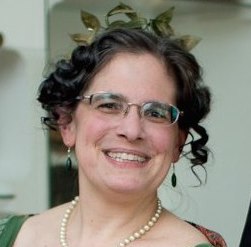Subtitled Nouveau Quadrille, Le Triangle is not actually a quadrille in the literal sense of a dance involving facing couples. It was composed by F. Paul and published in his manual, Le Cotillon, in Paris in 1877 and is danced by three couples rather than four, arranged in the form of a triangle. Paul composed it to address the difficulty of finding four couples for the quadrille croisé of the time. He adds modestly that he does not intend to impose it upon dancers, but gives the description only as a proposal. I have never seen Le Triangle in any other source; it may never have been danced outside of Paul’s immediate circles.
Le Triangle is a five-figure dance, with each figure danced twice. There is no specific music for it, but it was constructed to match the musical pattern of the first set of quadrilles as danced at that time, with each figure other than the second requiring thirty-two bars (the second figure is twenty-four bars) and the last figure having an additional eight bars added at the end. An eight-bar introduction to each figure is assumed, following standard nineteenth-century quadrille practice, but is nowhere mentioned in the instructions. A summary of the musical pattern:
Fig. 1 8b intro + 32bx2
Fig. 2 8b intro + 24bx2
Fig. 3 8b intro + 32bx2
Fig. 4 8b intro + 32b x2
Fig. 5 8b intro + 32b x2 + 8b
Numerous sets of sheet music were published for the first set during the late nineteenth century, so there are plenty of choices for Le Triangle.
The figures of the dance are mostly straightforward, but brief notes for each will be given below as required, with a longer note at the end regarding the “balance” figures.
I have not written out the eight-bar introduction to each figure in the reconstruction below.
Figure 1: Les Tours de Mains
8b All promenade
4b Right-hand turn with neighbor
4b Left-hand turn with partner, turning ladies into center to take right hands
8b (4b) Ladies right-hand moulinet around, (4b) left-hand turn with partner to places
8b Hands six and circle completely around
Figure 2: Les Promenades
4b All forward and back
4b Separate from partners and go halfway round, ladies inside to the left (clockwise) and gentlemen outside to the right (counter-clockwise)
8b (4b) All forward and back, (4b) and continue around in the same direction to places
8b (4b) Right hand turn with partner, (4b) left-hand turn with neighbor
Note that “halfway round” is to exactly opposite the starting positions, which reverses the orientation of the triangle.
Figure 3: Le Triangle
4b Balance forward and back to partners
4b Right-hand turn with partners to bring the ladies into the center in a left-hand moulinet, keeping right hands with partners
4b Balance right and left twice in moulinet formation
4b Holding the moulinet, gentleman turning to face counter-clockwise, circle halfway round, drawing women out to end next to partners opposite original places
8b Ladies forward and back twice, gentlemen once, two bars behind ladies (see note below)
8b (4b) All forward and back, (4b) all promenade halfway round to places
Note that for the staggered forward and back figure, the pattern is (2b) ladies forward, (2b) ladies back while gentlemen forward, (2b) gentlemen back while ladies forward, (2b) ladies back
Figure 4 Les Dos-à-Dos
8b All forward and back, then forward again, leave ladies in the center back to back, gentleman back to places
8b Ladies take hands and circle to their left (counter-clockwise) while gentlemen go round to their left (clockwise) on the outside
4b Balance forward and back to partners
4b Dos-à-dos with partners, traveling a little further around to take right hands with partner and left with neighbor in a circle
4b All move outward (enlarging circle) and inward (shrinking it)
4b Right hand turn with partner to places
Figure 5: La Chaine
8b Hands six and circle completely around
8b Ladies forward and back twice, gentlemen once two bars behind ladies as in Figure 3
4b Grand chain (rights and lefts) three changes, starting with right hands to partner, to come halfway around
4b Left-hand turn with partner
4b Grand chain home; three changes starting with left hands to partner
4b Right-hand turn with partner
(after the above is danced twice)
8b Hands six and circle completely round
Note that in the grand chain there are three changes in four bars (eight counts) instead of the usual two; take hands on counts one, four, and seven to make the timing work.
A note on the “balance” figures
Earlier in Paul’s manual, he describes the balance with partners (figures 3 & 4 below) as “chaque cavalier vis-à-vis de sa dame fait avec elle en avant et en arrière”, meaning to face your partner and move forward and back, rather than sideways as in earlier quadrille balancé figures. But in to balancé a quatre (figure 3 below), he explains that “les deux couples balancent sur place à droite et à gauche”, meaning to move slightly to the right and left.
Special thanks to Eowyn, Irene, Juliette, Marci, and Alexia for helping me dance-test Le Triangle!


Leave a Reply